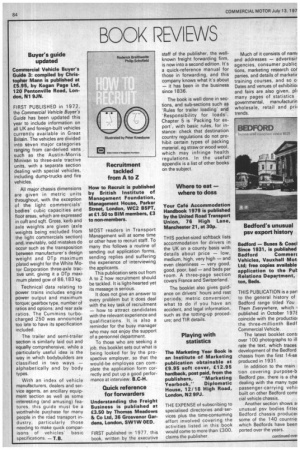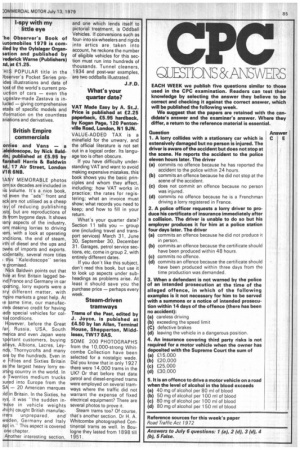BOO K REVIEWS
Page 86

Page 87

If you've noticed an error in this article please click here to report it so we can fix it.
Buyer's guide updated
Commercial Vehicle Buyer's Guide 3: compiled by Christopher Mann is published at £5.95, by Kogan Page Ltd, 120 Pentonville Road, London, Ni 9JN.
FIRST PUBLISHED in 1977, the Commercial Vehicle Buyer's Guide has been updated this year to include information on all UK and foreign-built vehicles currently available in Great Britain. The vehicles are divided into seven major categories ranging from car-derived vans such as the Austin-Morris Minivan to three-axle tractive units, with a separate section dealing with special vehicles. including dump-trucks and fire vehicles.
All major chassis dimensions are given in metric units throughout, with the exception of the light commercials' bodies' cubic capacities and floor areas, which are expressed in cuft and sqft. Gross, kerb and axle weights are given (axle weights being excluded from the light commercials section) and, inevitably, odd mistakes do occur such as the transposition between manufacturer's design weight and DTp maximum plated weight for the White Motor Corporation three-axle tractive unit, giving it a DTp maximum plated gcw of 86,183 kg.
Technical data relating to power trains includes engine power output and maximum torque; gearbox type, number of ratios and options; and rear axle ratios. The Cummins turbocharged 250 was announced too late to have its specification included.
The trailer and semi-trailer section is similarly laid out and equally comprehensive, while a particularly useful idea is the way in which bodybuilders are classified in two ways — alphabetically and by body types.
With an index of vehicle manufacturers, dealers and service agents, an ancillary equipment section as well as some interesting (and amusing) features, this guide must be a worthwhile purchase for many people in the road transport industry, particularly those needing to make quick comparisons of vehicles' basic specifications. — T.B.
Recruitment tackled from A to Z
How to Recruit is published by British Institute of Management Foundation, Management House, Parker Street, London, WC2 B5PT, at £1.50 to BIM members, £3 to non-members.
MOST readers in Transport Management will at some time or other have to recruit staff. To many this follows a routine of sending out application forms, sending replies and suffering the experience of interviewing the applicants.
This publication sets out from A to Z how recruitment should be tackled. It is light-hearted yet its message is serious.
It does not give an answer to every problem but it does deal with the key task of recruitment — how to attract candidates with the relevant experience and qualifications. It is also a reminder for the busy manager who may not enjoy the support of a personnel department.
To those who are seeking a job, this booklet sets out what is being looked for by the prospective employer, so that the would-be employee can complete the application form correctly and put up a good performance at interview. B.C-H.
Quick reference for forwarders
Understanding the Freight Business is published at £3.50 by Thomas Meadows & Co Ltd, 36 Grosvenor Gardens, London, SW1W OED.
FIRST published in 1977, this book, written by the executive staff of the publisher, the wellknown freight forwarding firm, is now into a second edition. It's a quick-reference manual for those in forwarding, and this company knows what it's about — it has been in the business since 1836.
The book is well done in sections, and sub-sections such as 'Rules for trailer loading' and 'Responsibility for loads'. Chapter 5 is 'Packing for export', with basic rules, for instance; check that destination country regulations do not prohibit certain types of packing material, eg straw or wood wool, which may infringe health regulations. In the useful appendix is a list of other books on the subject.
Where to eat — where to doss
Your Café Accommodation Handbook 1979 is published by the United Road Transport Union, 76 High Lane, Manchester 21, at 30p.
THIS pocket-sized softback lists accommodation for drivers in the UK on a county basis with details about price — low, medium, high, very high — and even cleanliness — very good, good, poor, bad — and beds per room. A three-page section covers France and Switzerland.
The booklet also gives guidance on drivers' hours and rest periods; metric conversion; what to do if you have an accident, and legal information, such as the totting-up procedure; and TIR details.
Playing with statistics
The Marketing Year Book is an Institute of Marketing publication obtainable at £9.95 soft cover, £12.95 hardback, post paid, from the publishers, "Marketing Yearbook," Diplomatic House, 12/18 High Road, London, N2 9 PJ .
THE EXPENSE of subscribing to specialised directories and services plus the time-consuming effort involved covering the activities listed in this book would come to more than £300, claims the publisher. Much of it consists of nami and addresses — advertisir agencies, consumer public tions, marketing research cor panies, and details of marketir training courses, and so or Dates and venues of exhibitioi and fairs are also given, ph many pages of statistics • governmental, manufacturin wholesale, retail and prii trends.
Bedford — Buses & Coacl Since 1931, is published
Bedford Commerc Vehicles, Vauxhall Mot, Ltd; free copies available application to the Puk Relations Department, ton, Beds.
THIS PUBLICATION is a pan to the general history of Bedford range titled You Them Everywhere, which published in October 197E coincide with the productioi the three-millionth Bedf Commercial Vehicle.
The latest booklet conti over 100 photographs to ill rate the text, which traces development of the Bedford chassis from the first 14-se produced in 1931.
In addition to the main : tion covering purpose-b Bedford psv, there is a cha dealing with the many type passenger-carrying vehii built on other Bedford comr cial vehicle chassis.
Another section shows sc unusual psv bodies fine( Bedford chassis produce( some of the 140 countrie: which Bedfords have been ported over the years.
l-spy with my. little eye
he Observer's Book of lutomobiles 1979 is comiiled by the Oylslager Organsation and published by rederick Warne (Publishers) td, at £1.25.
HIS POPULAR title in the thservers Pocket Series proides illustrations and data of losi of the world's current prouction of cars — even the ugoslav-made Zastava is inluded — giving comprehensive etails of specific models and Iformation on the countless ariations and derivatives.
British Empire commercials
orries and Vans — a :aleidoscope, by Nick Balden, published at £5.95 by larshall Harris & Baldwin td, 17 Air Street, London V1R 6NB.
lANY MEMORABLE photos orm six decades are included in is volume. It's a nice book, id even the "ads" front and ack are not utilised as a cheap ray of reducing publishing )Sts, but are reproductions of Js from bygone days. It shows any aspects of the industry, om making lorries to driving iem, with a look at operating mcitions, the end of steam, irth of diesel and the ups and Dwns of imports and exports. icidentally, several more titles this "Kaleidoscope" series -e promised.
Nick Baldwin points out that hile at first Britain lagged be4-id France and Germany in car (porting, lorry exports were a ary different matter, with -npire markets a great help. At ie same time, our manufacirers deserve credit for having lath special vehicles for collie' conditions.
However, before the Great tar, Russia, USA, South merica and even Japan were lportant customers, buying alleys, Albions, Lacres, Leyrids, Thornycrofts and many ore by the hundreds. Even in e '=ifties and Sixties Britain as the largest heavy lorry exgting country in the world. In e Twenties medium trucks )ured into Europe from the SA — 20 American marques )Id in Britain. In the Sixties, he )ys, it was "the sudden in'ease in vehicle weights whih) caught British manufac irers unprepared, and weden, Germany and Italy ap. in.'" This aspect is covered one chapter.
Another interesting section, and one which lends itself to pictorial treatment, is Oddball Vehicles. If conversions such as fourinto six-wheelers and rigids into artics are taken into account, he reckons the number of eligible vehicles for this section must run into hundreds of thousands. Tunnel cleaners, 1934 and post-war examples, are two oddballs illustrated.
J.F.D.
What's your quarter date?
VAT Made Easy by A. St.J. Price is published at £2.25 paperback, £5.95 hardback, by Kogan Page, 120 Pentonville Road, London, Ni 9JN.
VALUE-ADDED TAX is a minefield for the unwary, and the official literature is not set out in a logical order. Its language too is often obscure.
If you have difficulty understanding VAT and want to avoid making expensive mistakes, this book shows you the basic principles and whom they affect, including: how VAT works in practice; the rates for registering; what an invoice must show; what records you need to keep; and how to fill in your return.
What's your quarter date? Section 11 tells you — group one (including travel and transport services) March 31, June 30, September 30, December 31. Garages, petrol service sections, etc, come in group 2, with entirely different dates.
If you don't like this subject, don't read this book, but use it to look up aspects under subheadings as problems arise. At least it should save you the purchase price — perhaps every week.
Steam-driven tramways
Trams of the Past, edited by J. Joyce, is pubished at £4.50 by Ian Allan, Terminal House, Shepperton, Middlesex, TVV17 8AS.
SOME 200 PHOTOGRAPHS from the 10,000-strong Whitcombe Collection have been selected for a nostalgic wade. Did you know that in only 1927 there were 14,000 trams in the UK? Or that before that date petrol and diesel-engined trams were employed on several tramways where the traffic did not warrant the expense of fixed electrical equipment? There are several photos to prove it.
Steam trams too? Of course. that's another section. Dr H. A. Whitcombe photographed Continental trams as well. In Boulogne they lasted from 1898 till 1951.








































































































































